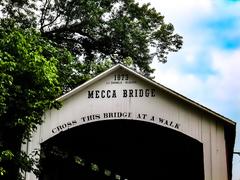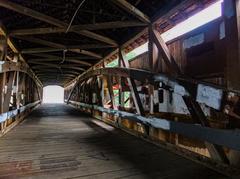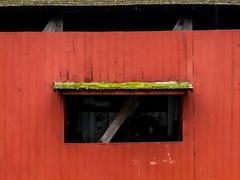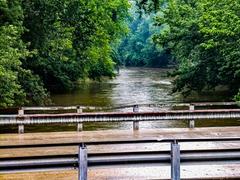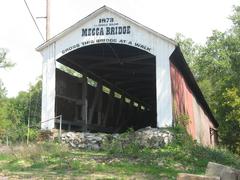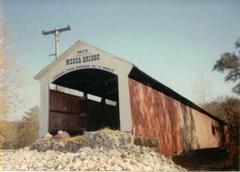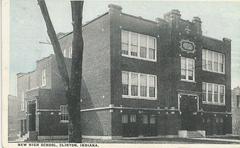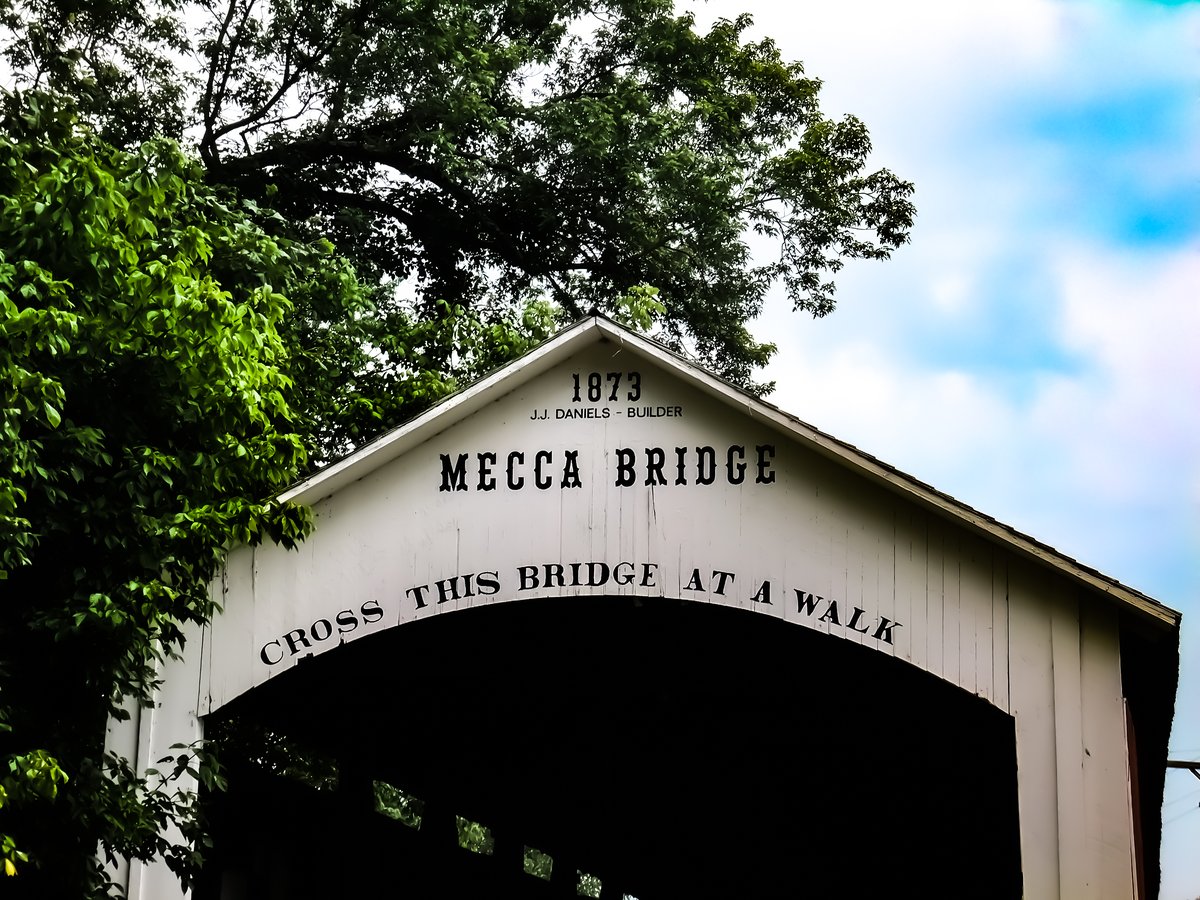
Visiting Mecca Covered Bridge: Hours, Tickets, and Historical Significance
Date: 01/08/2024
Introduction
The Mecca Covered Bridge, nestled in the charming town of Mecca, Indiana, is a captivating relic of 19th-century American architecture and engineering. Constructed in 1873 by the eminent bridge builder J.J. Daniels, this iconic structure spans the Big Raccoon Creek and epitomizes the Burr Arch Truss design, a patented innovation by Theodore Burr in 1804. The bridge’s historical significance is profound, serving as a crucial conduit for transportation and commerce during its early years and contributing to the economic vitality of the region (Indiana Covered Bridge Society, Parke County Historical Society).
Today, the Mecca Covered Bridge stands as an enduring symbol of Indiana’s rich heritage. Its preservation is a testament to the collaborative efforts of local communities and historical societies committed to maintaining this cultural landmark. Visitors are drawn to its rustic charm and historical ambiance, making it a popular destination for history enthusiasts, photographers, and tourists alike. The bridge is celebrated annually during the Parke County Covered Bridge Festival, showcasing its enduring cultural impact and drawing thousands of visitors to the area (Parke County Covered Bridge Festival).
Table of Contents
- Introduction
- Early Construction and Design
- Historical Significance
- Preservation Efforts
- Cultural Impact
- Visitor Information
- Nearby Attractions
- Architectural Details
- Modern-Day Relevance
- Visitor Experience
- FAQ Section
- Conclusion
Early Construction and Design
Constructed in 1873 by the notable bridge builder J.J. Daniels, the Mecca Covered Bridge spans the Big Raccoon Creek and is a testament to the ingenuity of its time. Daniels, renowned for his covered bridge designs, utilized the Burr Arch Truss design for the Mecca Covered Bridge. This design, patented by Theodore Burr in 1804, combines an arch with a multiple kingpost truss, providing both strength and durability (Indiana Covered Bridge Society).
Historical Significance
The Mecca Covered Bridge holds significant historical value, not just for its architectural design but also for its role in the development of the local community. During the late 19th and early 20th centuries, covered bridges were essential for transportation and commerce, facilitating the movement of goods and people across rivers and streams. The Mecca Covered Bridge was a crucial link for the residents of Mecca and the surrounding areas, contributing to the economic growth and connectivity of the region (Parke County Historical Society).
Preservation Efforts
Over the years, the Mecca Covered Bridge has undergone several restoration efforts to preserve its historical integrity and ensure its continued use. In 1969, the bridge was closed to vehicular traffic to protect its structure from modern wear and tear. However, it remains open to pedestrian traffic, allowing visitors to experience a piece of living history. In 2004, a significant restoration project was undertaken, funded by both state and local organizations, to repair and reinforce the bridge’s wooden components and foundation (Historic Bridges).
Cultural Impact
The Mecca Covered Bridge is more than just a functional structure; it is a cultural icon in Parke County, often referred to as the “Covered Bridge Capital of the World.” The bridge is one of 31 historic covered bridges in the county, which collectively attract thousands of visitors each year, particularly during the annual Parke County Covered Bridge Festival. This festival, held every October, celebrates the county’s rich history and heritage, with the Mecca Covered Bridge being a focal point of the festivities (Parke County Covered Bridge Festival).
Visitor Information
Visitors can explore the Mecca Covered Bridge year-round. Here are some key details:
- Visiting Hours: The bridge is open to pedestrians 24/7.
- Tickets: There is no admission fee to visit the bridge.
- Accessibility: The bridge and surrounding park are accessible to visitors of all ages and abilities.
- Special Events: The Parke County Covered Bridge Festival in October is a must-see event.
- Travel Tips: Wear comfortable walking shoes and bring a camera to capture the scenic beauty.
Nearby Attractions
While in Parke County, visitors can explore several other attractions:
- Turkey Run State Park: Known for its beautiful hiking trails and scenic views.
- Billie Creek Village: A historical village with preserved buildings and artifacts.
- Bridgeton Mill: A historic mill offering tours and fresh-ground products.
Architectural Details
The Mecca Covered Bridge measures 176 feet in length and 16 feet in width, with a clearance height of 13 feet. The bridge’s wooden components are primarily constructed from white pine, a common material for covered bridges due to its strength and availability. The Burr Arch Truss design not only provides structural support but also adds an aesthetic element, with its graceful curves and intricate joinery. The bridge’s exterior is clad in vertical wooden siding, painted in a traditional red color, believed to help preserve the wood and make the bridge more visible to travelers (Bridgehunter).
Modern-Day Relevance
Today, the Mecca Covered Bridge stands as a symbol of the region’s historical and cultural heritage. It is a popular destination for tourists, history enthusiasts, and photographers, offering a glimpse into the past and a picturesque setting for various activities. The bridge’s preservation and continued use highlight the importance of maintaining historical structures, not only for their aesthetic and educational value but also for their role in connecting communities and preserving local history (Indiana Landmarks).
Visitor Experience
Visitors to the Mecca Covered Bridge can enjoy a variety of activities, from leisurely walks across the bridge to exploring the surrounding natural scenery. The bridge is located within the Mecca Covered Bridge Park, which offers picnic areas, walking trails, and informational plaques detailing the bridge’s history and significance. The park is open year-round, providing a serene and educational experience for visitors of all ages. Additionally, the nearby town of Mecca offers various amenities, including local shops, restaurants, and accommodations, making it an ideal destination for a day trip or weekend getaway (Visit Indiana).
FAQ Section
Q: What are the visiting hours for the Mecca Covered Bridge? A: The bridge is open to pedestrians 24/7.
Q: Is there an admission fee to visit the Mecca Covered Bridge? A: No, there is no admission fee.
Q: Are there any special events held at the Mecca Covered Bridge? A: Yes, the Parke County Covered Bridge Festival in October is a significant event.
Q: What nearby attractions can I visit? A: Turkey Run State Park, Billie Creek Village, and the Bridgeton Mill are popular nearby attractions.
Conclusion
The Mecca Covered Bridge is a remarkable example of 19th-century engineering and a vital part of Indiana’s historical landscape. Its preservation and continued use as a pedestrian bridge ensure that future generations can appreciate and learn from this iconic structure. Whether visiting during the annual Covered Bridge Festival or exploring the bridge and its surroundings at any other time of the year, the Mecca Covered Bridge offers a unique and enriching experience for all who visit. Stay up to date with the latest information and events by following us on social media and downloading the Audiala app for more travel tips and historical insights.
References
- Indiana Covered Bridge Society. (n.d.). Retrieved from https://www.indianacoveredbridges.com
- Parke County Historical Society. (n.d.). Retrieved from https://www.parkecountyhistory.org
- Parke County Covered Bridge Festival. (n.d.). Retrieved from https://www.coveredbridges.com
- Historic Bridges. (n.d.). Retrieved from https://www.historicbridges.org
- Indiana Landmarks. (n.d.). Retrieved from https://www.indianalandmarks.org
- Visit Indiana. (n.d.). Retrieved from https://www.visitindiana.com
